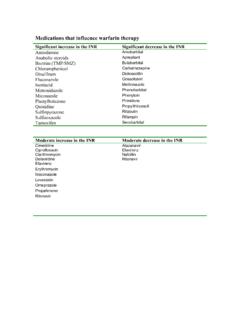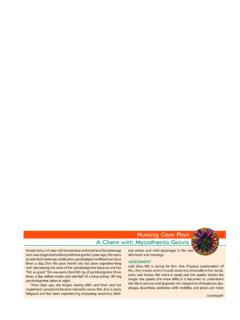Transcription of Myasthenia Gravis for the Internist - Silkview Design
1 Thayer Firm 2005-2006. Myasthenia Gravis for the Internist Priscilla Brastianos 1. Neurologic disorder characterized by muscle weakness worsened by muscled use and improved w/ rest 2. Epidemiology: women in 20s-30s, men >60. 3. Pathogenesis: auto-Ab's vs. acetylcholine receptor (80-90% of cases), muscle specific receptor tyrosine kinase Ab's 4. Clinical manifestations: a. Cardinal feature: degree of weakness worsens w/ exercise of affected muscles, improves w/ rest b. Eye muscles: ptosis, diplopia (extraocular eye muscle involvement). c. Bulbar muscles: facial muscle weakness (smiling), weakness of palate and tongue, difficulty chewing, difficulty swallowing, choking d. Limb and trunk muscles: usually proximal muscles e. Respiratory muscle depression 5. Diagnosis: a. Physical exam: i. Inducible ptosis by sustained upward gaze ii. Fatigue of upper extremities after outstretched arms iii.
2 Breath count deep inspiration followed by counting out quickly during expiration (<20 FVC<1). iv. Weakness w/ neck flexion (and extension): 4/5 or less is concerning v. Symptoms worst at night b. Tensilon test: i. IV injection of Edrophonium chloride (acetylcholinesterase inhibitor). c. EMG studies, repetitive nerve stimulation 6. Triage: a. Patient history - # intubations, bipap, common Myasthenia triggers (ex infection, medication, noncompliance), Myasthenia manifestations specific for that particular patient b. Breath count (<20 is concerning) compare to baseline c. Low FVC (<=1 or compared to baseline) measure ABG if you don't think they need intubation in next 20 min. d. Intubate if necessary (FVC much lower than baseline, esp if <1, use of accessory muscles, concerning ABG). e. Consider q4h FVCs f. Consider neuro c/s *Note: low FVC (or breath count) can be result of poor effort always look at patient, assess overall clinical status, and remember that FVCs may vary according to how tired the patient is (time of day) and when they got their last dose of Ach-i 7.
3 Management: a. Pyridostigmine (mestinon) acetylcholinesterase inhibitor i. Muscarinic side effects abdominal cramping, diarrhea, fasciculations, weakness (distinguish from weakness caused by if assoc. w/ diarrhea). b. Aspiration precautions, consider nocturnal BIPAP (for tenuous patients). c. Immunosuppressive agents i. Azathioprine, Cyclosporine, Mycophenolate (cellcept), Plasmapheresis, IVIg ii. Steroids may initially worsen Myasthenia , so start in hospital d. Thymectomy 8. Myasthenic crisis: a. Elective intubation for respiratory depression (esp w/ FVC <1) > admit to NCCU (or MICU, if NCCU full). b. Plasmapheresis or IVIg c. IV neostigmine d. Mortality 4 %. Drugs to avoid in Myasthenia Drugs that impair N-M transmission and may increase weakness Antibiotics Aminoglycosides: tobramycin, gentamycin, netilmicin, neomycin, streptomycin, kanamycin Fluoroquinolones: ciprofloxacin, norfloxacin, ofloxacin, gatifloxacin Tetracyclines clindamycin Sulfonamides Penicillins considered safe, though anecdotes of ampicillin causing resp depression Macrolides.
4 Azithromycin, clarithromycin Ritonavir Quinolones quinidine, quinine, chloroquine Magnesium containing -avoid hypermagnesemia preparations -avoid magnesium containing drugs in renal failure Drugs implicated as potentially harmful in Myasthenia Gravis patients based on either anecdotal case reports or in-vitro microelectrode studies Beta blockers propanolol, oxprenolol, timolol, practolol, atenolol, labetalol, metoprolol, nadolol Calcium channel blockers verapamil Other cardiac drugs procainamide, bretylium, trimethaphan Anticonvulsants phenytoin, barbiturates, ethosuximide, gabapentin Ophthalmologic meds timolol Psychiatric meds lithium, phenothiazines, amitriptyline, imipramine, amphetamines, haldol







